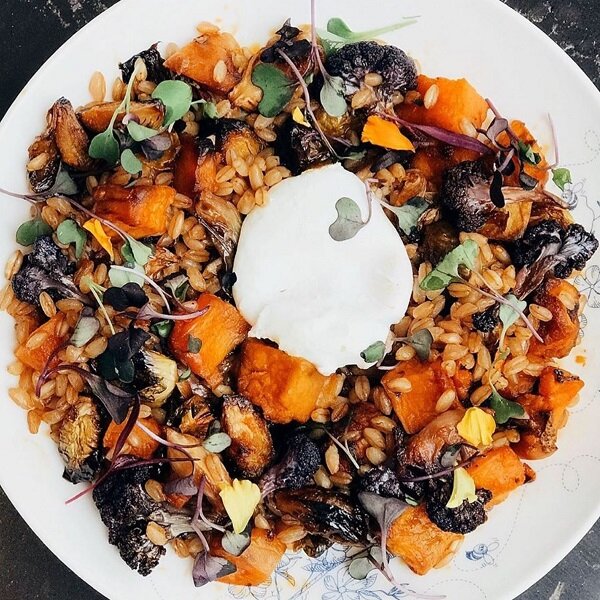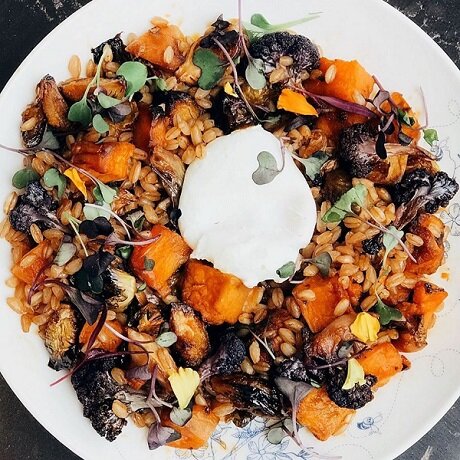My Rules for Perfectly Roasted Veggies
For a biscuit joint, we offer and cook a lot of vegetables. Our Veggie Hash is frequently a bestseller. We mix local, seasonal, and often organic vegetables with farro that’s been cooked in apple cider vinegar (always Sparrow Lane) and veggie stock and finish the entire dish with paprika oil, capers, and lemon, then top it with a poached egg. I get asked weekly, mostly by Elizabeth Todd, how to properly roast vegetables at home. There is not an exact recipe for how we get a perfectly roasted and charred veggie for our hash, but there is a set of rules and a technique that works well with almost all vegetables so that you can enjoy your farmer’s market haul at home.  1) You need your oven to be very hot. Much hotter than you think. 500 degrees hot. If your oven doesn’t easily get hot, then put your baking sheet in the oven before adding your veggies and get it as hot as possible. 2) Make sure all of your vegetable pieces are cut to a similar size so that they will cook evenly. You don’t want a few very burnt pieces and some very undercooked pieces. 3) Try not to mix vegetable types on the same sheet tray. Each veg will cook at varying times and you want to remove them as they are finished. For example, if you are roasting carrots, do not mix them with broccoli. Roast carrots on one baking sheet and broccoli on a separate tray. 4) You need toss your veggies in some sort of fat — avocado, coconut, and grapeseed oils are great choices as they won’t burn and maintain much of their nutritional integrity through the cooking process. Do not use olive oil it smokes too easily and is too expensive to waste on a high-temperature roast. 5) Toss your veggies (in a bowl, do not do it on the tray, I know it creates more dishes, but do you want delicious roasted vegetables or don’t you?) in enough fat to just coat the outside and then salt them. This step is crucial to bringing seasoning to your food. If you salt after the roast, your veggies will taste saltier. Trust me. You want to see the salt on the veggies. I use Diamond Krystal Kosher Salt. 6) Put the veggies in the oven. They will be hot! 7) A general rule is that brown food tastes good. You are trying to create a Maillard reaction, which is a chemical reaction akin to caramelization. It helps create the sweet, bitter, and toasty notes that make food taste interesting. So keep roasting! 8) Check on the veggies every five to seven minutes. You want veggies that are cooked and that have a identifiable char (even a little burn is great). If you are unsure if they are done, simply taste each time you check. If they taste great, perfect! If not, keep cooking! You can even remove half and cook the other half a little longer to see if you like it. 9) After the vegetables are done, toss with a little acid -- lemon juice or vinegar. Again, start small. Taste your food. If you taste it and the veggies are a little brighter in flavor and not heavy in your mouth, stop adding acid and enjoy. 10) The great thing about preparing veggies this way is you can store and reuse them. You can enjoy cold or reheat on the stove or the oven.
1) You need your oven to be very hot. Much hotter than you think. 500 degrees hot. If your oven doesn’t easily get hot, then put your baking sheet in the oven before adding your veggies and get it as hot as possible. 2) Make sure all of your vegetable pieces are cut to a similar size so that they will cook evenly. You don’t want a few very burnt pieces and some very undercooked pieces. 3) Try not to mix vegetable types on the same sheet tray. Each veg will cook at varying times and you want to remove them as they are finished. For example, if you are roasting carrots, do not mix them with broccoli. Roast carrots on one baking sheet and broccoli on a separate tray. 4) You need toss your veggies in some sort of fat — avocado, coconut, and grapeseed oils are great choices as they won’t burn and maintain much of their nutritional integrity through the cooking process. Do not use olive oil it smokes too easily and is too expensive to waste on a high-temperature roast. 5) Toss your veggies (in a bowl, do not do it on the tray, I know it creates more dishes, but do you want delicious roasted vegetables or don’t you?) in enough fat to just coat the outside and then salt them. This step is crucial to bringing seasoning to your food. If you salt after the roast, your veggies will taste saltier. Trust me. You want to see the salt on the veggies. I use Diamond Krystal Kosher Salt. 6) Put the veggies in the oven. They will be hot! 7) A general rule is that brown food tastes good. You are trying to create a Maillard reaction, which is a chemical reaction akin to caramelization. It helps create the sweet, bitter, and toasty notes that make food taste interesting. So keep roasting! 8) Check on the veggies every five to seven minutes. You want veggies that are cooked and that have a identifiable char (even a little burn is great). If you are unsure if they are done, simply taste each time you check. If they taste great, perfect! If not, keep cooking! You can even remove half and cook the other half a little longer to see if you like it. 9) After the vegetables are done, toss with a little acid -- lemon juice or vinegar. Again, start small. Taste your food. If you taste it and the veggies are a little brighter in flavor and not heavy in your mouth, stop adding acid and enjoy. 10) The great thing about preparing veggies this way is you can store and reuse them. You can enjoy cold or reheat on the stove or the oven.

